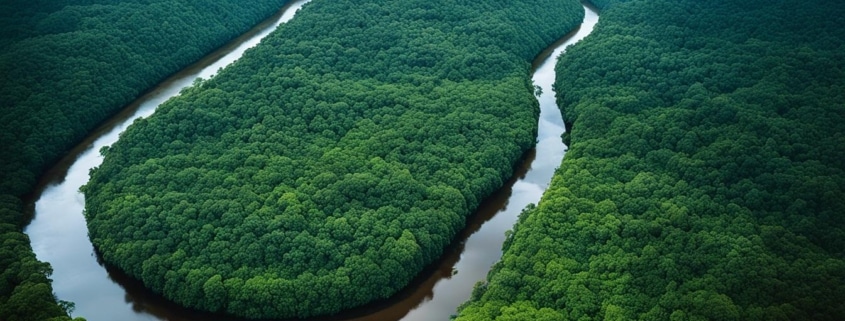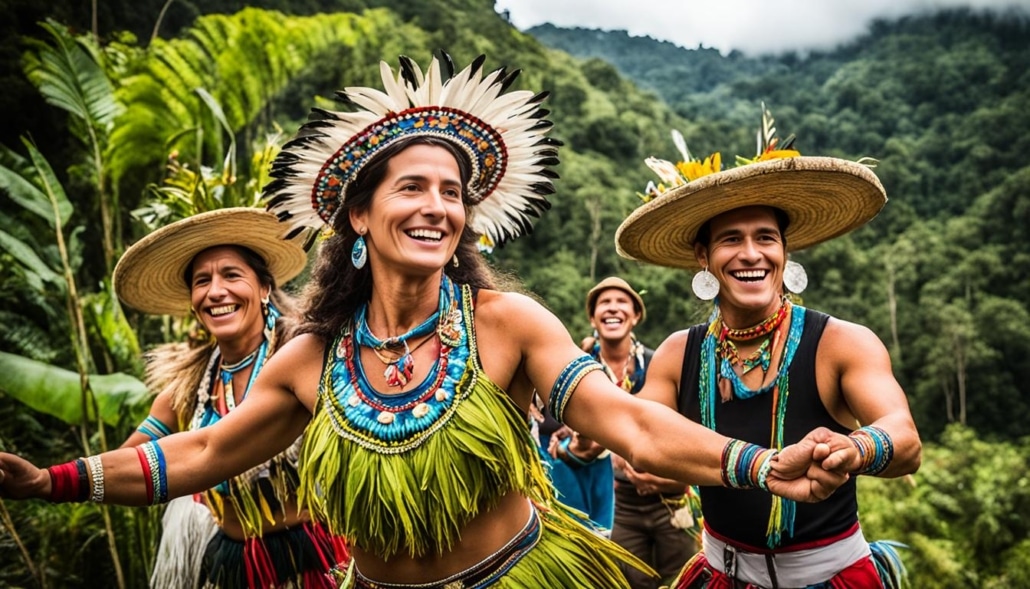Discover the Heart of the Amazon: A Guide to Responsible Travel
The Amazon Rainforest is a remarkable destination known for its unparalleled biodiversity and natural beauty. Responsible travel to this incredible ecosystem is not only an opportunity to immerse yourself in the enchanting wonders of nature but also a chance to make a positive impact and contribute to its preservation.
Eco-tourism, also known as sustainable travel, is a key aspect of exploring the Amazon Rainforest responsibly. By adopting eco-friendly practices and supporting local communities, travelers can help protect the environment, conserve wildlife habitats, and preserve the rich cultural heritage of the region.
Key Takeaways:
- Responsible travel to the Amazon Rainforest involves minimizing your impact on the environment and supporting local communities.
- Eco-tourism focuses on sustainable practices such as reducing waste, conserving energy, and respecting the local culture.
- Choosing a responsible tour operator like Kuoda ensures adherence to strict environmental standards and promotes conservation efforts.
- Stay at eco-lodges that prioritize sustainability, such as Inkaterra Reserva Amazonica, Tambopata Ecolodge, and Pacaya Samiria Amazon Lodge.
- Respect the local culture by asking for permission, supporting the community’s economy, and refraining from taking items from the rainforest.
Choose a Responsible Tour Operator
When planning your trip to the Amazon Rainforest, it is essential to select a responsible tour operator that prioritizes sustainable tourism. By choosing a responsible tour operator, you can ensure that your travel experience not only benefits you but also contributes to the conservation and protection of the Amazon ecosystem.
One of the leading responsible tour operators in the industry is Kuoda. As a Positive Climate certified company, Kuoda is committed to sustainability and adheres to strict environmental standards. They go above and beyond to minimize their impact on the environment and promote responsible travel practices.
Why Choose Kuoda?
“At Kuoda, we believe that sustainable tourism is the future. We aim to provide unique and unforgettable experiences while simultaneously safeguarding the incredible biodiversity and cultural heritage of the Amazon Rainforest.”
Kuoda Team
Here are some reasons why Kuoda stands out as a responsible tour operator:
- Supports eco-friendly accommodations: Kuoda works with eco-lodges and sustainable accommodations that prioritize environmental conservation and sustainability.
- Minimizes waste and energy consumption: They actively strive to reduce waste and energy consumption throughout their operations, ensuring minimal impact on the fragile ecosystem.
- Promotes conservation efforts: Kuoda collaborates with local communities and organizations to support conservation initiatives, such as reforestation, wildlife protection, and sustainable development projects.
- Respects indigenous cultures: The team at Kuoda emphasizes cultural exchange and respects the traditions and customs of the indigenous communities in the Amazon Rainforest.
By choosing Kuoda as your tour operator, you can embark on a responsible and sustainable journey through the Amazon Rainforest, knowing that your travel experience is not only enriching but also contributing to the preservation of this unique and irreplaceable natural wonder.
Choose Sustainable Accommodations
When planning a trip to the Amazon Rainforest, it’s important to consider staying at sustainable accommodations that prioritize eco-friendly practices and responsible tourism. These sustainable accommodations, often known as eco-lodges, offer an immersive and environmentally conscious experience while providing luxury and comfort for travelers.
Eco-lodges in the Amazon Rainforest are designed to minimize their impact on the environment and support the local communities. They promote sustainable practices in various ways, such as energy conservation, waste reduction, and the use of renewable resources. By choosing to stay at these accommodations, you can contribute to the preservation of the Amazon Rainforest and its delicate ecosystem.
Here are some examples of sustainable eco-lodges in the Amazon Rainforest:
- Inkaterra Reserva Amazonica: Located in Peru, Inkaterra Reserva Amazonica is an eco-luxury lodge that offers a unique blend of comfort and sustainability. The lodge provides opportunities for guests to explore the rainforest while participating in conservation programs and supporting the local indigenous communities.
- Tambopata Ecolodge: Situated in the Tambopata National Reserve in Peru, Tambopata Ecolodge is committed to responsible tourism and the protection of the rainforest. The lodge offers educational activities, guided excursions, and comfortable accommodations that blend seamlessly with the natural surroundings.
- Pacaya Samiria Amazon Lodge: Located in the Pacaya Samiria National Reserve in Peru, this lodge provides a sustainable and immersive experience in the heart of the Amazon Rainforest. Guests can explore the reserve’s pristine wilderness, learn about conservation efforts, and engage with the local communities.
These eco-lodges not only offer a unique and authentic experience in the Amazon Rainforest but also contribute to the preservation of this diverse ecosystem. By supporting sustainable accommodations, travelers can play a vital role in promoting responsible tourism and safeguarding the Amazon Rainforest for future generations.
Respect the Local Culture
When visiting the Amazon Rainforest, it’s important to respect the culture and traditions of the local indigenous communities. These communities have a deep connection to the land and play a vital role in the preservation of the Amazon Rainforest. By honoring their customs, travelers can contribute to the cultural preservation and sustainable development of the region.
One key aspect of respecting the local culture is seeking permission before taking photos of community members or entering their homes. This shows respect for their privacy and ensures that their wishes are honored. It is important to remember that indigenous communities are not tourist attractions but thriving communities with their own way of life.
Furthermore, travelers can support the local economy by buying locally-made souvenirs. Many indigenous communities are skilled artisans and craftsmen, creating beautiful and unique handicrafts that reflect their cultural heritage. Purchasing these souvenirs directly from the artisans helps to support their livelihoods and keeps traditional craftsmanship alive.
“Respecting the local culture of indigenous communities in the Amazon Rainforest is essential for responsible travel. By seeking permission, valuing their customs, and supporting their economy, travelers can contribute to the preservation of these vibrant cultures.”
The Benefits of Respecting the Local Culture:
- Preserves cultural heritage and traditions
- Fosters mutual understanding and respect between travelers and indigenous communities
- Supports the local economy and sustainable development
- Contributes to the preservation of the Amazon Rainforest
| Do’s | Don’ts |
|---|---|
|
|
Reduce Your Waste
Minimizing waste is crucial for preserving the delicate ecosystem of the Amazon Rainforest. By implementing simple practices, you can make a significant difference in reducing your environmental impact.
One effective way to reduce waste is to carry reusable water bottles and food containers during your visit. This eliminates the need for single-use plastic bottles and takeaway containers, which can contribute to pollution and harm wildlife in the Amazon Rainforest.
To further minimize waste, it is important to stay on designated trails when hiking. Straying from the designated paths can damage plants and disturb the habitat of wildlife. By respecting the rules and guidelines set by local authorities, you contribute to the conservation of the Amazon Rainforest.
Benefits of Reducing Waste in the Amazon Rainforest:
- Protects the fragile ecosystem of the rainforest
- Prevents pollution from single-use plastics
- Preserves the habitat of wildlife
- Supports sustainable tourism practices
Tips for Reducing Waste:
- Carry reusable water bottles and food containers
- Avoid using single-use plastics
- Dispose of waste properly in designated bins
- Stay on designated trails when hiking
By consciously making these choices, you can contribute to the conservation efforts and help protect the mesmerizing beauty of the Amazon Rainforest for generations to come.
Do Not Take Items From the Rainforest
Taking items from the rainforest not only disrupts the delicate balance of the ecosystem but also poses a threat to the survival of endangered species and protected plants. The Amazon Rainforest is home to a wide array of unique flora and fauna that depend on their natural habitat for sustenance and reproduction.
By removing items from the rainforest, you contribute to the depletion of vital resources and disrupt the ecological processes that support the diverse wildlife and plant species. This can have significant consequences for the entire ecosystem, leading to the decline of various species and the degradation of their natural habitats.
Rainforest conservation is of utmost importance as it safeguards the intricate web of life within the ecosystem. Taking items from the rainforest jeopardizes not only the survival of endangered species but also the ecological resilience of the entire region.
Remember, it is not only unethical but also illegal to take certain items from the Amazon Rainforest. Endangered species and protected plants are strictly regulated to ensure their preservation and prevent their exploitation.
Engaging in responsible and sustainable travel means respecting the laws and regulations governing rainforest conservation. Failure to comply with these laws can result in severe consequences, including legal action and fines.
Protecting the rainforest and its inhabitants is a shared responsibility. By refraining from taking items from the rainforest, we contribute to the preservation of this extraordinary ecosystem and ensure the long-term survival of its myriad of species.
Protected Plants in the Amazon Rainforest
| Common Name | Scientific Name | Status |
|---|---|---|
| Brazil Nut Tree | Bertholletia excelsa | Protected |
| Victoria Amazonica | Victoria cruziana | Endangered |
| Carnauba Wax Palm | Copernicia prunifera | Protected |
| Passionflower | Passiflora edulis | Endangered |
Impacts of Taking Items From the Rainforest
- Disruption of the delicate ecosystem balance
- Loss of habitat for endangered species
- Depletion of vital resources
- Compromised ecological resilience
- Damage to the overall biodiversity of the rainforest
Learn About the Wildlife at a Distance
The Amazon Rainforest is a haven for a diverse range of plant and animal species. It is a remarkable opportunity to learn about and appreciate the natural beauty of the Amazon wildlife. However, it is crucial to keep a safe distance and avoid disturbing the delicate balance of the ecosystem. Engaging in responsible wildlife observation is key to preserving the Amazon Rainforest for future generations.
When encountering wildlife in the Amazon Rainforest, it is essential to observe from a distance and avoid any actions that may cause disturbance. The wildlife has adapted to their natural environment, and interference can disrupt their behavior and stress them. By respecting their habitat and maintaining a safe distance, travelers can contribute to the conservation efforts of the Amazon’s unique biodiversity.
“The wildlife of the Amazon Rainforest is awe-inspiring and fragile. We must act responsibly to protect their habitats and ensure that future generations can also witness their beauty.”
One of the common mistakes tourists make is feeding the animals. While it may seem harmless, this can greatly impact their natural behavior and even make them aggressive towards humans. Feeding disrupts their balanced diet, making them reliant on humans and altering their behavior patterns. It is important to refrain from feeding any wildlife in the Amazon Rainforest to preserve their natural instincts and maintain the integrity of the ecosystem.
By adopting responsible wildlife observation practices, visitors can help protect the delicate balance of the Amazon Rainforest and contribute to the ongoing efforts of wildlife conservation. Appreciating the magnificence of Amazon wildlife from a distance ensures the preservation of their natural habitat and the long-term sustainability of this remarkable ecosystem.
Our Commitment to Wildlife Conservation
As passionate advocates for wildlife conservation, we are dedicated to promoting the responsible observation of Amazon wildlife. We believe in the power of education and raising awareness to preserve the fragile ecosystems and protect the diverse species that call the Amazon Rainforest home.
To deepen your understanding of the remarkable Amazon wildlife, here are a few notable species:
| Amazon Wildlife | Description |
|---|---|
| Jaguar | The largest predatory cat in the Americas, known for its unique spotted coat and remarkable hunting abilities. |
| Scarlet Macaw | A vibrant and colorful bird species endemic to the Amazon Rainforest, featuring a long tail and a distinctive call. |
| Sloths | These slow-moving, tree-dwelling mammals possess a unique charm with their leisurely lifestyle and gentle demeanor. |
| Black Caiman | A large predatory reptile found in the Amazon Basin, known for its dark coloration and impressive stealth hunting skills. |
Remember, observing these incredible creatures in their natural habitat is a privilege. Let’s ensure their well-being and the preservation of their environment for generations to come.
Conclusion
Sustainable travel to the Amazon Rainforest is a vital step towards preserving this unique and biodiverse ecosystem. By adopting responsible tourism practices, travelers can minimize their impact on the environment and support the local communities that call the Amazon their home.
Choosing a responsible tour operator, such as Kuoda, ensures that sustainability and environmental conservation are prioritized. By working with local communities and promoting eco-friendly accommodations, these operators contribute to the preservation of the Amazon Rainforest.
When exploring this magnificent region, it is crucial to respect the local culture and traditions of indigenous communities. Seek permission before taking photos or entering their homes, and consider purchasing locally-made souvenirs to support their economy.
Minimizing waste is another essential aspect of responsible travel. Carry reusable water bottles and food containers to avoid using single-use plastic, and follow designated trails to avoid disrupting plants and wildlife.
Remember, it is illegal to take items from the rainforest, including protected plants and endangered species. By refraining from removing these items, travelers can contribute to the conservation efforts and the long-term health of the Amazon Rainforest. Finally, appreciate the unique wildlife from a safe distance, as disturbing their natural behavior can have harmful consequences.
Through sustainable travel practices, we can all play a part in protecting the Amazon Rainforest for generations to come. By making conscious choices and supporting responsible tourism, we can preserve this invaluable natural treasure and ensure a bright future for the Amazon and its communities.
FAQ
What is responsible travel?
Responsible travel refers to a way of traveling that minimizes the negative impact on the environment and local communities. It involves sustainable practices, supporting local economies, and respecting cultural traditions.
Why is it important to choose a responsible tour operator in the Amazon Rainforest?
Choosing a responsible tour operator ensures that your travel activities align with sustainable practices. They prioritize environmental conservation, support local communities, and provide educational experiences while minimizing their impact on the delicate ecosystem of the Amazon Rainforest.
What are some examples of sustainable accommodations in the Amazon Rainforest?
Examples of sustainable accommodations in the Amazon Rainforest include Inkaterra Reserva Amazonica, Tambopata Ecolodge, and Pacaya Samiria Amazon Lodge. These eco-lodges prioritize sustainability and responsible practices while offering luxury and comfort to travelers.
How should I respect the local culture in the Amazon Rainforest?
To respect the local culture in the Amazon Rainforest, always ask for permission before taking photos or entering indigenous communities’ homes. Look for locally-made souvenirs to support the community’s economy and show appreciation for their traditions.
What can I do to reduce waste in the Amazon Rainforest?
Minimizing waste is crucial in the fragile ecosystem of the Amazon Rainforest. Carry reusable water bottles and food containers to avoid using single-use plastic. Ensure proper waste disposal and stay on designated trails when hiking to avoid damaging plants and wildlife.
Why should I not take items from the rainforest?
Taking items from the rainforest disrupts the delicate balance of the ecosystem and can have a negative impact on flora and fauna. It is also illegal to take certain items, including endangered species and protected plants. Travelers can face legal consequences and fines if caught.
How should I behave around wildlife in the Amazon Rainforest?
While it’s important to appreciate the natural beauty of wildlife in the Amazon Rainforest, it’s crucial to keep a safe distance and avoid disturbing them. Feeding animals can disrupt their natural behavior and potentially make them aggressive. Always view wildlife from a safe distance and follow any guidelines provided by your tour operator or guide.






Leave a Reply
Want to join the discussion?Feel free to contribute!